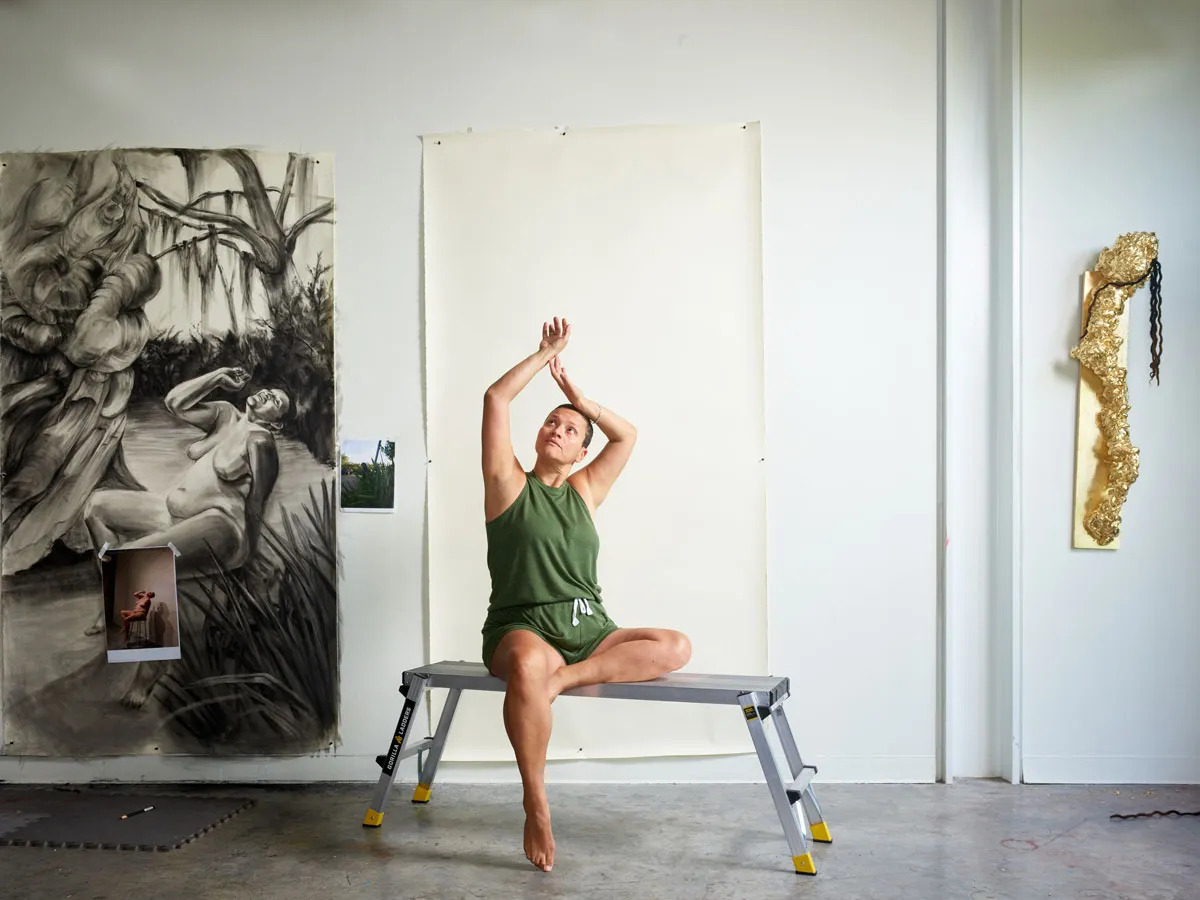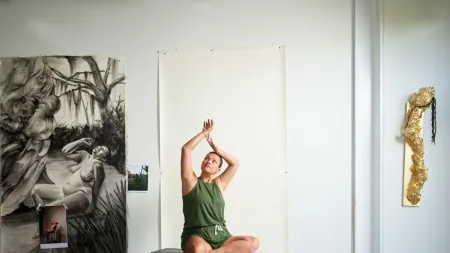
“I realized I had been struggling with how people fucked with me and my hair when I wore it naturally,” artist Wanda Raimundi-Ortiz said in a recent interview. “My hair was magnificent. I used to go to the Dominican hair salon, and they would always try to straighten it even though I just went for a haircut. The Blackest part of me was my hair and people would try to strip me from my Blackness.”
Hair forms the central focus of Raimundi-Ortiz’s latest solo exhibition, “Sanctuary: My Place in the World” at the Eckert Art Gallery at Millersville University in Pennsylvania, where she is currently a visiting artist. On view until October 26, the exhibition highlights Raimundi-Ortiz’s “Wig Variants” series, a mixture of photographs and hand-drawn portraits in pencil of different variations of Wanda, as well as her new related “Sanctuary” series.
Some of the works on view show her sitting or standing in the nude, others in regalia in nature near water and surrounded by trees and their branches, which take the shape of braids and directly reference her experience as an Afro-Boricua woman. A large-scale triptych, Las Evas, Sancuary Series (2022), shows four nude women in various states of repose in a clearing filled with two large trees. These new portraits, showing the artist in moments of interiority and joy, represent a marked shift in her work. Since early last year, Raimundi-Ortiz decided that “she will no longer bleed on the canvas every time she goes to the studio.”

For the past two decades, Raimundi-Ortiz has created character-driven, performative works exploring conversations around race relations, critical race theory, and anti-Blackness from exploring her relationship with her mom through Afro-Puerto Rican music to creating two distinct alter two egos from the hood (Wepa Woman and Chuleta) that facilitated a new sense of awakening leading her to this current work. “The bulk of my early work was rooted in frustration, feeling unseen and unheard as an individual and a group of people. I didn’t know it at the time, but I feel like I was creating that work as a consciousness of the people, as a dialogue [with them],” she told ARTnews.
After studying illustration at the Fashion Institute of Technology, Raimundi-Ortiz thought she might go into fashion or comic book illustration. But one day in the early 2000s, while she was working as a window display assistant for Macy’s, she received a call from an emerging artist at the time who had heard of Raimundi-Ortiz’s work and wanted her to be his assistant. She would use that income to subsidize her studio work, which at the time focused on large-scale drawings and a comic book series.
But it wasn’t until the Sept. 11 attacks, however, that she fully dedicated herself to being an artist. At a time when her work felt so insignificant given what had just happened, she told herself, “Déjate de la mierda. [Leave that shit behind.] If you’re going to live this life, you really need to follow it. You need to do it.”

Looking to artists of her generation, like Simone Leigh, Wangechi Mutu, Leslie Hewitt, and Elia Alba, but with little official mentorship, Raimundi-Ortiz slowly began to locate her voice as an artist. A 2002 residency at the esteemed Skowhegan School of Painting and Sculpture in Maine would prove consequential, and she soon turned to performance art, starting on her first body of work in that vein the following year.
Tapping into their Puerto Rican lineage, Raimundi-Ortiz and two friends Marlyn Matias-Feliciana and Cinderella Marin created El Camino (2002–03), a series of walks that first took tours around Hunts Point in the Bronx and later were performed along the stretch of Fifth Avenue in Manhattan known as Museum Mile and at the Bronx Academy of Art and Dance. For the performances, they dressed in bomba clothes made of heavy, layered laundry linens trying to find a place where they can wash their clothes but never quite getting there. Symbolically it was “trying to connect my life to my mom’s life but the space was too wide,” Raimundi-Ortiz said.
Raimundi-Ortiz continued to explore the struggle she felt between both loving and hating her sense of self and her upbringing in works like RicanStruction (2003), an installation re-creating a Nuyorican beauty parlor at Exit Art gallery where Wanda did makeovers to make guests look Latina, and Wepa Woman (2005–12), a comic series about a Nuyorican super hero critiquing the hood. “It helped me figure out how I can live in between these two worlds, and I realized this served as a conduit,” she said.

Simultaneously, Raimundi-Ortiz also decided to turn that critique on herself. In Ask Chuleta: Contemporary Art (2006–13), she responds to her own harsh judgment of the hood that she portrayed in Wepa Woman and took it a step further, questioning who she was being a superhero to. In these short YouTube videos, she embodies an intrigued and street-smart Nuyorican named Chuleta, who criticizes the art world in layman’s terms—and with sophistication and sass. In one video, Chuleta denounces the practice of embracing—and by extension tokenizing—artists of color who created art that reflected their struggles, trauma, and suffering, while at the same excluding the communities of color who would relate to it. Though she was still early in her career, Raimundi-Ortiz found that in embodying Chuleta she was able to stand up to the powers that be in the art world, on her own terms. “Chuleta was and is my alter ego,” she explained, “and she’s everything my mother told me not to be. But in order not to be something, you end up studying it really well, and in activating her I got to understand my community better.”
This new consciousness developed over a period of performance art series where she played and explored themes of intimacy, vulnerability, and empathy while still giving space for personal trauma. For Hush (2011), an installation that included a bed in the middle of the gallery, Raimundi-Ortiz laid down and invited visitors to lay with her to laugh, talk, and be in silence. In Las Reinas (The Queens), from 2012–15, she dressed in various outfits of royal attire that represented different personal fears she felt and challenges she experienced. The Pieta Series staged in 2017 at the National Portrait Gallery in Washington, D.C., saw the artist sit on a bench in extravagant regalia designed by Kristina Tollefson and every 3.33 seconds she tightly embraced someone as a response to the killing of Trayvon Martin and the birth of Raimundi-Ortiz’s own child.
For a public performance Exodus/Pilgrimage (2019), in downtown Orlando, where she lived for 12 years, Raimundi-Ortiz dressed in 50 pounds of debris from the catastrophic Hurricane Maria that devastated Puerto Rico in 2017 that took the form of Afro–Puerto Rican folkloric wardrobe, combining FEMA tarps and found objects like sheet music, kitchen tools, and Medalla street billboards—evidence of lives interrupted. As she dragged herself through downtown Orlando, followed by plena singers, they ended up at the Dr. Phillips Performing Arts Center with a bombazo where people danced together.

The staging of Exodus/Pilgrimage was a bit of full circle moment for Raimundi-Ortiz, calling back to her El Camino performances two decades earlier, and even serving as a metaphorical farewell to mining her pain and trauma in her art. Now, 20 years later, Raimundi-Ortiz said she no longer wants to “depict trauma porn or cut from the cloth of Black and Brown people but rather be fully aligned with joy and transcending my pain.”
In this way, her latest exhibition, “Sanctuary” is about this transcendence: finding and enjoying happiness despite the struggles, creating work from radical joy, celebrating the feeling that she has arrived, and simply savoring her talents as a draftsman. Part of her turn to this new style is reflecting on what artist Yashua Klos once told her, “You should make the work that a museum can’t tell a story without.” For Raimundi-Ortiz, people of color experiencing radical joy is a story worth telling.
What exactly does that look like, to create depictions of joy in the face of constant racial bias, anti-Blackness, and trauma? Raimundi-Ortiz put it simply: “Like Kerry James Marshall—just celebrating things. Black folks having coffee. That shouldn’t be extraordinary. I just don’t want to anchor the struggle to validate the joy. Because we all know it’s rough. How am I helping uplift my community if I keep pouring cement? Let’s just hang out—it hurts anyway.”
Correction, September 26, 2023: An earlier version of this article misattributed a remark by Yashua Klos to Pepón Osorio.

The 11 Most Anticipated Restaurant Openings in America This Fall

H&M Group Q3 Sales Flat as It Cuts Inventory, Costs

Did the LG Gram Fold fix the foldable screen creasing problem?

Endeavor’s Appeal Denied in COVID-19 Insurance Lawsuit


